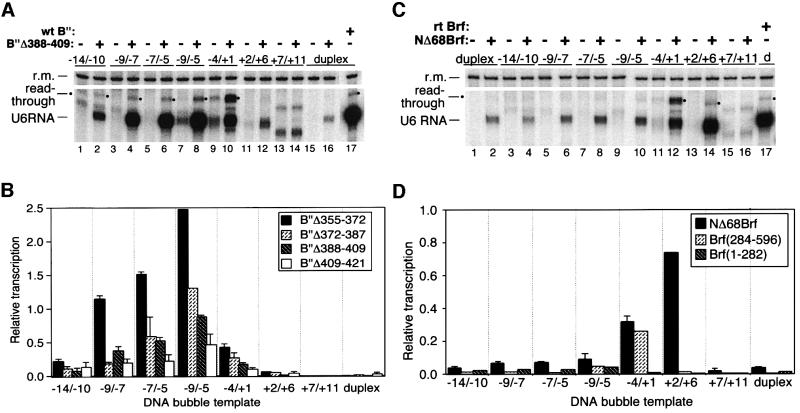Fig. 3. Promoter opening defects due to B” internal deletions and a Brf N-terminal deletion are rescued by 3 and 5 bp heteroduplex bubbles. (A) The –9/–7, –7/–5 and –9/–5 bubbles rescue the transcriptional defect of B”Δ388–409. DNA templates and the presence of B” are specified above each lane. The U6 transcript and recovery marker (r.m.) are designated to the left; a circle designates the read-through transcript. Only the transcript corresponding to r-U6 in Figure 1 is produced with this transcription template, which extends only to bp –60 (see Materials and methods). (B) Quantitative summary of the rescue of transcription defects generated by B” deletions through partial promoter opening. Data from nine experiments similar to (A) are presented for four internal deletions of B” covering amino acids 355–421. Transcription efficiency is normalized to a wild-type TFIIIB–fully duplex DNA transcription standard used in each experiment, after subtracting a background of B′′-independent transcription for each template. Average values and average deviations from two to three experiments are shown. (C and D) Bubbles also rescue the transcriptional defects of Brf deletions. (C) A +2/+6 bubble restores transcription factor activity of TFIIIB assembled with NΔ68Brf. The DNA template and the presence of Brf are specified above each lane. (D) Summary of the effects of bubbles on transcription with NΔ68Brf and the separate N- and C-terminal halves of Brf. Presentation of data as in (B). Data for NΔ68Brf are averages from two experiments; the rest are single experiments. The prominent read-through transcripts of the –4/+1 bubble template in (A) and (C) are probably due to RNA–DNA hybrid formation with displacement of the non-transcribed DNA strand (Campbell and Setzer, 1992).

An official website of the United States government
Here's how you know
Official websites use .gov
A
.gov website belongs to an official
government organization in the United States.
Secure .gov websites use HTTPS
A lock (
) or https:// means you've safely
connected to the .gov website. Share sensitive
information only on official, secure websites.
